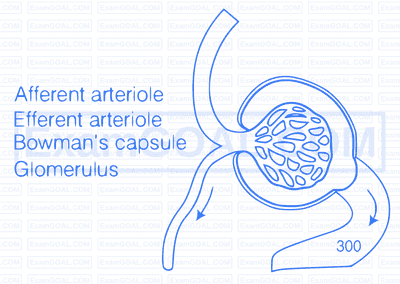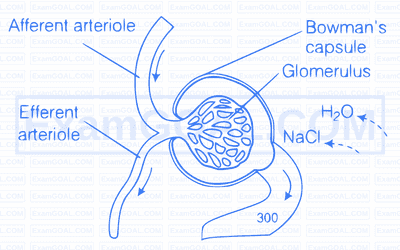Terrestrial adaptation necessitated the production of lesser toxic nitrogenous wastes like urea and uric acid for the conservation of water. Mammals and many terrestrial amphibians mainly excrete urea and are called uriotelic animals. Ammonia produced by metabolism is converted into urea in the liver of these animals and released into the blood, which is filtered and excreted out by the kidneys. Some urea is retained in kidney in order to maintain osmolarity, reptilelos birds, land snails and insects excrete nitrogeneous waste, as uric acid in the form of pellet or paste with a minimum loss of water and are called uricotelic animals. Conversion of ammomia to uric acid and its subsequent elimination requires lesser amount of water. Hence, due to less availability of water on land, and in order to minimise water loss, terrestrial organism adapted themselves accordingly.
Label the parts in the following figure.

The labelling part of the given figure are as listed

Haemodialysis This method is a boon for thousands of uremic (accumulation of urea in blood) patients all over the world.
Haemodialysing unit act an on artificial kidney by removing urea from patients blood due to kidney failure. In this process blood is drained from artery an pumped into a dialysing unit after the addition of an anticoagulant like heparin.
The unit contains a coiled cellophane tube surrounded by a dialysing fluid having the same composition as that of plasma except nitrogenous waste. The porous cellophane membrane of the tube allows the passage of molecules based on concentration gradient.
Due to the absence of nitrogenous wastes in dialysing fluid these substances freely move out, thereby clearing the blood.
In the end the cleared blood is pumped back to the body through a vein after the addition of anti-heparin to it thereby completing the process.

The functioning of the kidneys is efficiently monitored and regulated by Antidiuretic Hormone (ADH), Juxtaglomerular Apparatus (JGA) and Atrial Natriuretic Factor (ANF).
(a) Antidiuretic Hormone (ADH) or vasopressin from the neurohypophysis, facilitates water reabsorption from latter parts of tubule, i.e., distal convoluted tubule and collecting duct by increasing the permeability to water and salt and by accelerating water and ion transfer in a direction determined by the osmotic gradient.
(b) Juxta Glomerular Apparatus (JGA) operates a multihormonal. Renin Angiotensin Aldosterone System (RAAS). JG cells secrete an enzyme, renin, which, changes plasma protein called angiotensinogen to a peptide called angiotensin I and further to angiotensin II, which works as a hormone.
Angiotensin II, being a powerful vasoconstrictor increases the glomerular blood pressure and thereby GFR. It also stimulate's soduim absorption by proximal tubules.
(c) Angiotensin II also activates the adrenal cortex to release aldosterone. Aldosterone induces the distal convoluted tubule to absorb more $\mathrm{Na}^{+}$and water.
(d) Atrial Natriuretic Factor (ANF) is produced by the atria of heart. It regulates blood flow by causing vasodilation and increasing sodium excretion. It is also involved in checking of renin-angiotensin mechanism.